Welcome Unit Discovering useful structures八种基本句型学案(无答案) -2025-2026学年高中英语人教版(2019)必修第一册
文档属性
| 名称 | Welcome Unit Discovering useful structures八种基本句型学案(无答案) -2025-2026学年高中英语人教版(2019)必修第一册 | 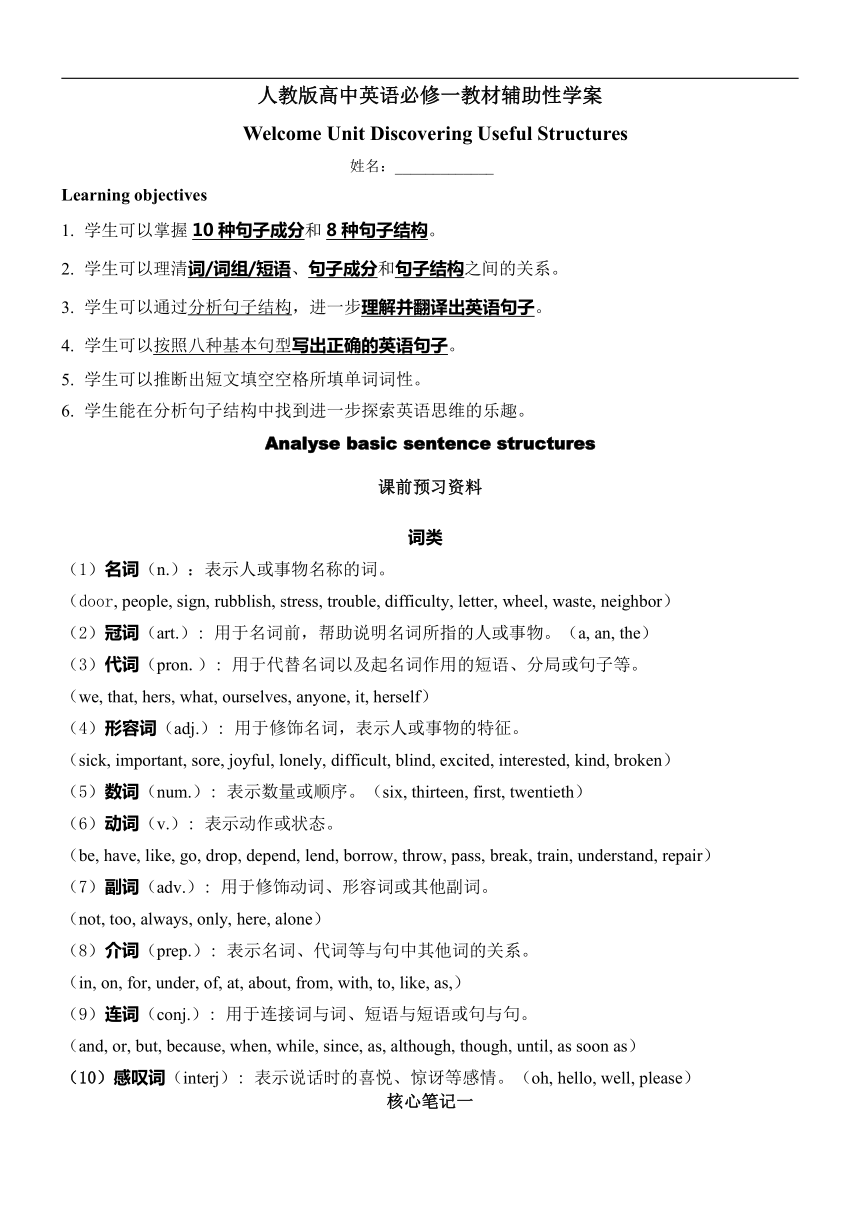 | |
| 格式 | docx | ||
| 文件大小 | 85.7KB | ||
| 资源类型 | 教案 | ||
| 版本资源 | 人教版(2019) | ||
| 科目 | 英语 | ||
| 更新时间 | 2025-07-24 12:11:38 | ||
图片预览

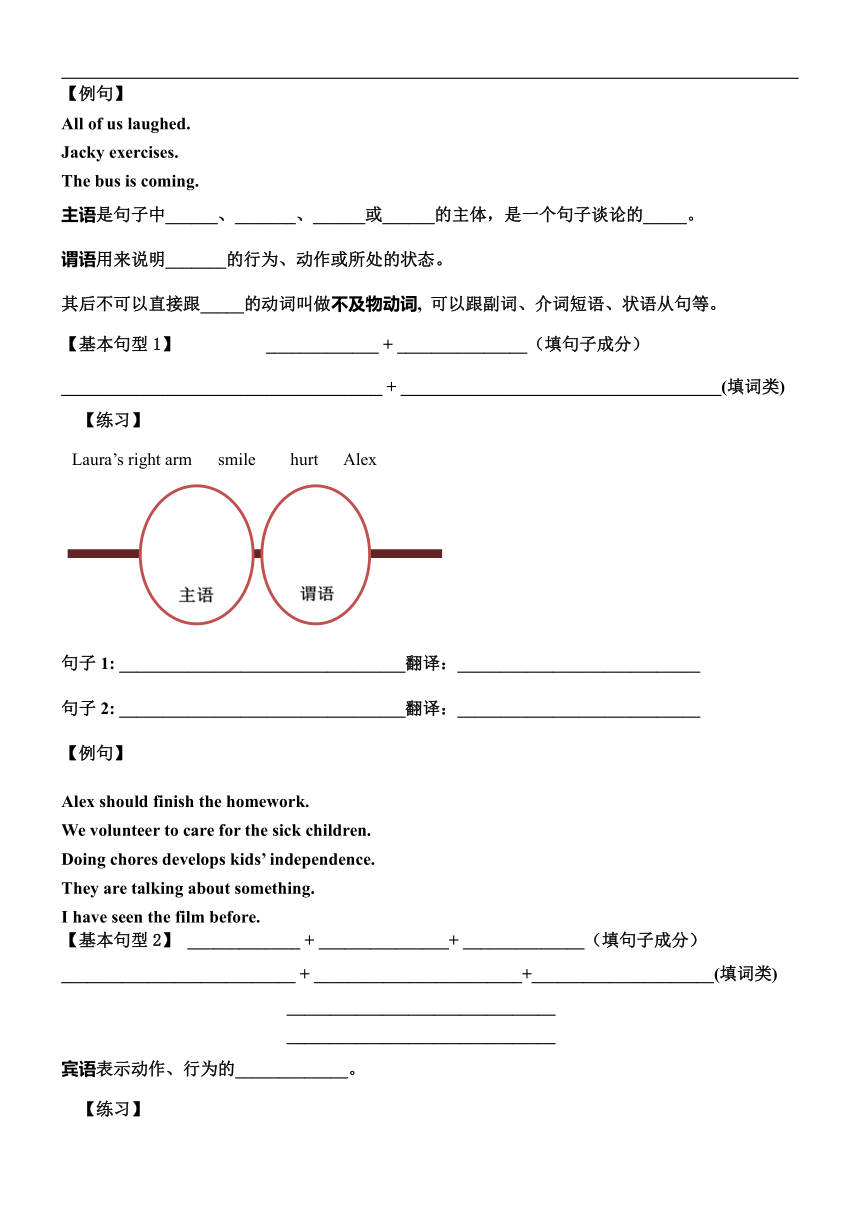
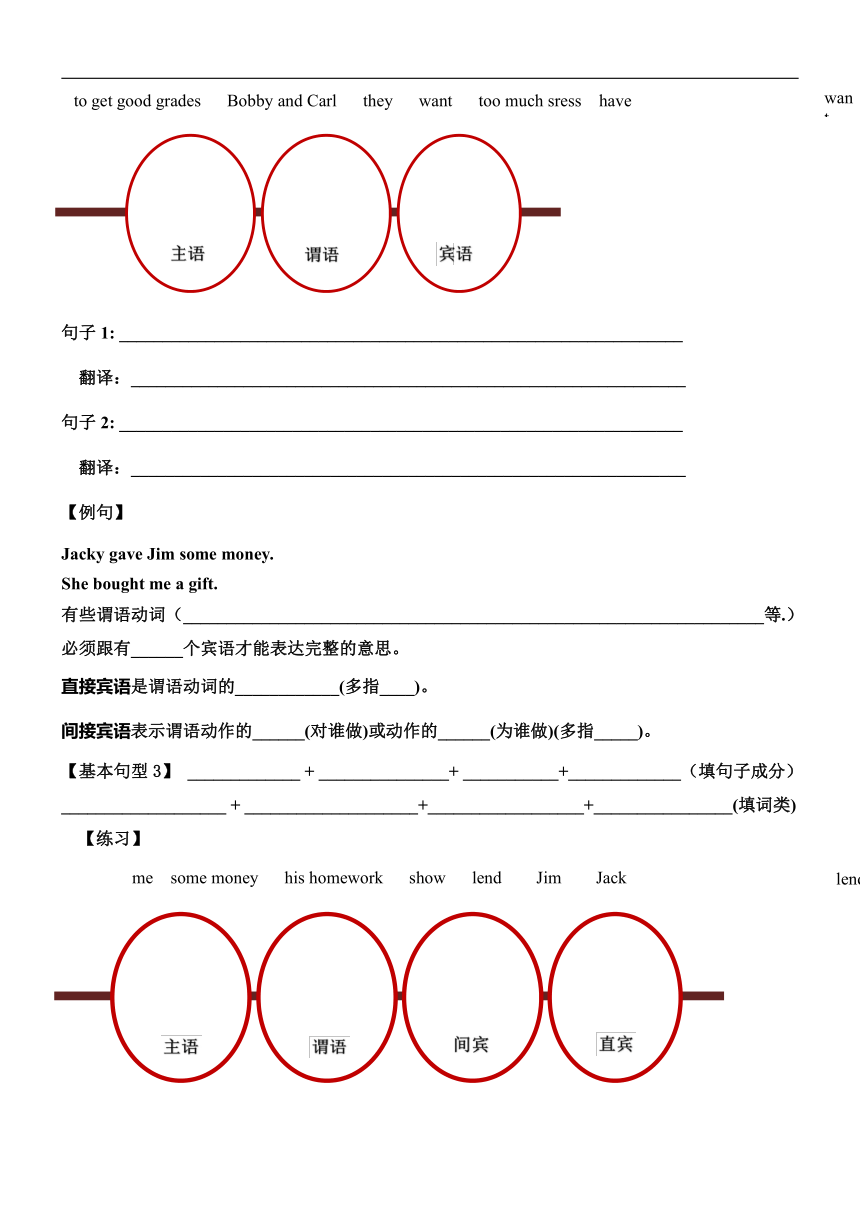
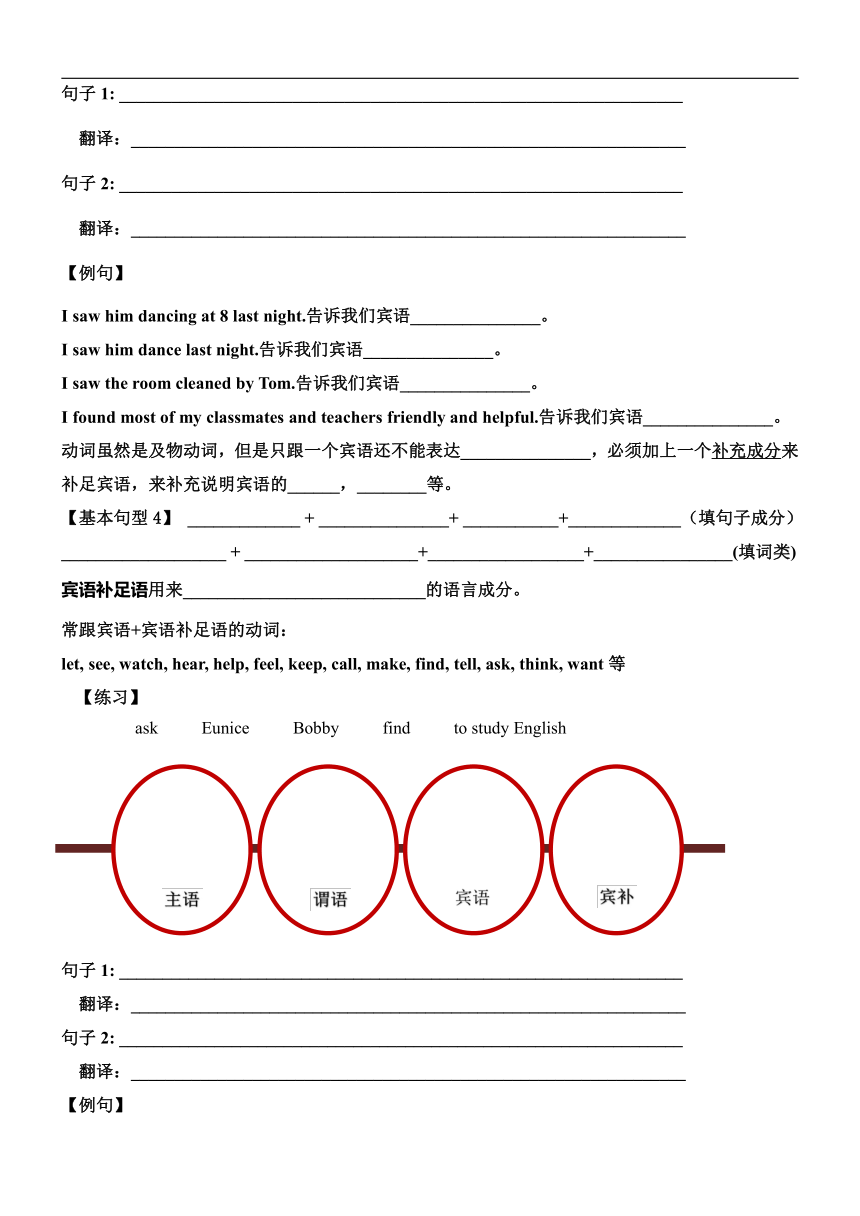
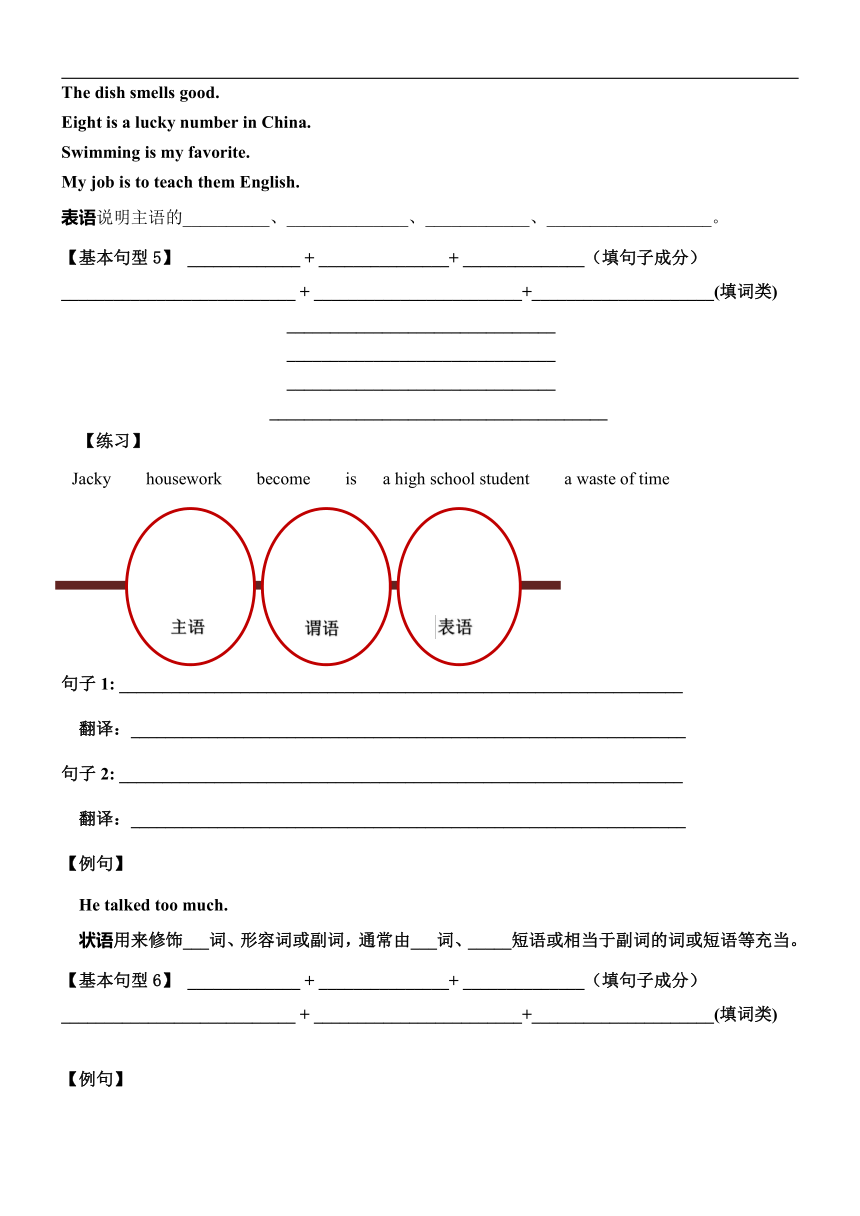
文档简介
人教版高中英语必修一教材辅助性学案
Welcome Unit Discovering Useful Structures
姓名:_____________
Learning objectives
学生可以掌握10种句子成分和8种句子结构。
学生可以理清词/词组/短语、句子成分和句子结构之间的关系。
学生可以通过分析句子结构,进一步理解并翻译出英语句子。
学生可以按照八种基本句型写出正确的英语句子。
学生可以推断出短文填空空格所填单词词性。
学生能在分析句子结构中找到进一步探索英语思维的乐趣。
Analyse basic sentence structures
课前预习资料
词类
名词(n.):表示人或事物名称的词。
(door, people, sign, rubblish, stress, trouble, difficulty, letter, wheel, waste, neighbor)
冠词(art.): 用于名词前,帮助说明名词所指的人或事物。(a, an, the)
代词(pron.): 用于代替名词以及起名词作用的短语、分局或句子等。
(we, that, hers, what, ourselves, anyone, it, herself)
形容词(adj.): 用于修饰名词,表示人或事物的特征。
(sick, important, sore, joyful, lonely, difficult, blind, excited, interested, kind, broken)
数词(num.): 表示数量或顺序。(six, thirteen, first, twentieth)
动词(v.): 表示动作或状态。
(be, have, like, go, drop, depend, lend, borrow, throw, pass, break, train, understand, repair)
副词(adv.): 用于修饰动词、形容词或其他副词。
(not, too, always, only, here, alone)
介词(prep.): 表示名词、代词等与句中其他词的关系。
(in, on, for, under, of, at, about, from, with, to, like, as,)
连词(conj.): 用于连接词与词、短语与短语或句与句。
(and, or, but, because, when, while, since, as, although, though, until, as soon as)
感叹词(interj): 表示说话时的喜悦、惊讶等感情。(oh, hello, well, please)
核心笔记一
【例句】
All of us laughed.
Jacky exercises.
The bus is coming.
主语是句子中______、_______、______或______的主体,是一个句子谈论的_____。
谓语用来说明_______的行为、动作或所处的状态。
其后不可以直接跟_____的动词叫做不及物动词, 可以跟副词、介词短语、状语从句等。
【基本句型1】 _____________ + _______________(填句子成分)
_____________________________________ + _____________________________________(填词类)
【练习】
句子1: _________________________________翻译:____________________________
句子2: _________________________________翻译:____________________________
【例句】
Alex should finish the homework.
We volunteer to care for the sick children.
Doing chores develops kids’ independence.
They are talking about something.
I have seen the film before.
【基本句型2】 _____________ + _______________+ ______________(填句子成分)
___________________________ + ________________________+_____________________(填词类)
_______________________________
_______________________________
宾语表示动作、行为的_____________。
【练习】
句子1: _________________________________________________________________
翻译:________________________________________________________________
句子2: _________________________________________________________________
翻译:________________________________________________________________
【例句】
Jacky gave Jim some money.
She bought me a gift.
有些谓语动词(___________________________________________________________________等.)
必须跟有______个宾语才能表达完整的意思。
直接宾语是谓语动词的____________(多指____)。
间接宾语表示谓语动作的______(对谁做)或动作的______(为谁做)(多指_____)。
【基本句型3】 _____________ + _______________+ ___________+_____________(填句子成分)
___________________ + ____________________+__________________+________________(填词类)
【练习】
句子1: _________________________________________________________________
翻译:________________________________________________________________
句子2: _________________________________________________________________
翻译:________________________________________________________________
【例句】
I saw him dancing at 8 last night.告诉我们宾语_______________。
I saw him dance last night.告诉我们宾语_______________。
I saw the room cleaned by Tom.告诉我们宾语_______________。
I found most of my classmates and teachers friendly and helpful.告诉我们宾语_______________。
动词虽然是及物动词,但是只跟一个宾语还不能表达_______________,必须加上一个补充成分来补足宾语,来补充说明宾语的______,________等。
【基本句型4】 _____________ + _______________+ ___________+_____________(填句子成分)
___________________ + ____________________+__________________+________________(填词类)
宾语补足语用来____________________________的语言成分。
常跟宾语+宾语补足语的动词:
let, see, watch, hear, help, feel, keep, call, make, find, tell, ask, think, want等
【练习】
句子1: _________________________________________________________________
翻译:________________________________________________________________
句子2: _________________________________________________________________
翻译:________________________________________________________________
【例句】
The dish smells good.
Eight is a lucky number in China.
Swimming is my favorite.
My job is to teach them English.
表语说明主语的__________、______________、____________、___________________。
【基本句型5】 _____________ + _______________+ ______________(填句子成分)
___________________________ + ________________________+_____________________(填词类)
_______________________________
_______________________________
_______________________________
_______________________________________
【练习】
句子1: _________________________________________________________________
翻译:________________________________________________________________
句子2: _________________________________________________________________
翻译:________________________________________________________________
【例句】
He talked too much.
状语用来修饰___词、形容词或副词,通常由___词、_____短语或相当于副词的词或短语等充当。
【基本句型6】 _____________ + _______________+ ______________(填句子成分)
___________________________ + ________________________+_____________________(填词类)
【例句】
I have my first class at senior high school .
Last night she didn’t go to the dance party because of the rain.
状语用来补充__________,_________,_________,_________,_______________等信息。
【基本句型7】 _____________ + _______________+ ___________+_____________(填句子成分)
___________________ + ____________________+__________________+________________(填词类)
【例句】
There are three people in my uncle’s family.
There is a pen and two books on the desk.
There isn’t a boy in the room.
There aren’t any books on the desk.
There’s a lot to explore at senior high.
There’s a boy sitting under the tree.
【基本句型8】 _______________________________________
含义:_______________________________________________________________________________
注意;________________________________________________________________________________
小思考
[一般简单句]
Bobby ate an apple.Bobby吃了一个苹果。
[较复杂简单句]
Little Bobby standing under the tree ate a very big apple imported from the USA on Tuesday.
句意:_______________________________________________________________________________
定语用来修饰、限定、说明______或___________的__________与____________的。
核心笔记默写单一
句子成分:组成句子的各个部分叫做句子的成分。
句子成分包括________、__________、___________、_____________、________________、________________、______________、___________和________________。
其中,________和_______是句子的主体部分。翻译出一个句子的___和___语,就理解句子大意了。
八种基本句型
_______________________________________________
_______________________________________________
_______________________________________________
_______________________________________________
_______________________________________________
_______________________________________________
_______________________________________________
_______________________________________________
提升训练
找出下列句子中的主语
My hotel is near downtown, in the Mission District, one of the oldest parts of the city.
The girl he gave the flowers to is Rose.
I did not love writing. My family came from Brazil, so English was only my second language. Writing was so difficult and painful for me.
It seems to me that the traditional Chinese dress will make the occasion very Chinese and inviting to the British students.
找出下列句子中的谓语
I am writing to ask for your guidance on a short play.
He looked after two orphans.
Our school was built in 2017.
He can speak English very well.
The work must be done before three o’clock
找出下列句子中的宾语
1. Richard does not like his job.
2. Monica decide to solve the problem on her own.
3. The young man risk losing his life to save the girl.
4. They offered me the job.
5. I would like you to give us your guidance and encouragement.
找出下列句子中的补语
1. We sincerely wish you a quick recovery and an early return
2. He was seen playing basketball on the playground yesterday.
3. We'll try our best to make our country more and more beautiful.
4. Lijiang will make the Chinese culture better known to British students.
5. Tired and sleepy, I went to bed.
找出下列句子中的表语
1. They are exchange students
2. Needless to say, they were deeply moved.
3.That's why I think the trip along the Yangtze River will be a better choice.
4.Julie always looks cheerful.
5.My favourite sport is running.
6.So attractive and alive do they look that I think you could be interested in the exhibition.
找出下列句子中的状语
The next day, we set off early in the morning.
If you want a deep experience in the city, shared bikes would be the best choice.
We are training very hard these days.
When I came back home, I shared my experiences with my parents.
找出下列句子中的定语
1. This is a difficult problem
2. He works in a trade company.
3. The lady was carrying a basket full of vegetables.
4. The girl in white is his sister.
5. Do you know the man speaking to our headmaster
6. We should adapt to the changing situation quickly.
找出下列句子中的同位语
1. I'm Li Jin, a student at Chenguang High School.
2. The question whether it is right or wrong depends on the result.
3. This is Mr Li, our headmaster.
4. We each have an English name now.
5. The news that our team has won again is true.
核心笔记二
句子成分
(1)主语是句子中______、_______、______或______的主体,是一个句子谈论的_____。
通常由_______________________________________________________________________等充当。
(2)谓语用来说明_______的行为、动作或所处的状态。
谓语包括_______________________________________________________________________________________________________________________________________________________________________________________________________________________________________________________________________________________________________________________________________________________________________________________________________________________________________________________________________________________________________________________
(2)宾语表示动作、行为的_____________。
通常由_______________________________________________________________________等充当。
有些谓语动词(___________________________________________________________________等.)
必须跟有______个宾语才能表达完整的意思。
(3)直接宾语是谓语动词的____________(多指____)。
(4)间接宾语表示谓语动作的______(对谁做)或动作的______(为谁做)(多指_____)。
(5)宾语补足语用来____________________________的语言成分。
通常由_______________________________________________________________________等充当。
表语说明主语的__________、______________、____________、___________________。
通常由_______________________________________________________________________等充当。
(7)状语用来修饰___词、形容词或副词,通常由___词、_____短语或相当于副词的词或短语等充当。
通常由_______________________________________________________________________等充当。
(8)状语用来补充__________,_________,_________,_________,_______________等信息。
(9)定语用来修饰、限定、说明______或___________的__________与____________的。
前置定语通常由________________________________________________________________等充当。
后置定语通常由________________________________________________________________等充当。
(10)同位语是在名词或代词之后的并列名词或代词,与前者指代同一事物,只是加以说明,为同位关系。同位语只有主语和宾语才有,可以由名词、代词以及从句充当。并且同位语一般紧跟在它所修饰的词之后,充当的语法成分与前面的词一致。
e.g. Mr. Smith, our new teacher, is very kind to us.
我们的新老师史密斯先生对我们很好。
句子的类型
简单句:由一个_____语(或并列主语)和一个_________语(或并列谓语)构成的句子。
八种基本句型
_______________________________________________
_______________________________________________
_______________________________________________
_______________________________________________
_______________________________________________
_______________________________________________
_______________________________________________
_______________________________________________
并列句:由并列连词(and, so, but, or等)把两个或两个以上的简单句连载一起而构成的句子。
She often drinks juice and she never stays up late.
Ed has a great sports collection, but he doesn’t play sports.
School starts at eight, so I get up at six thirty.
练一练: Don’t trouble trouble until trouble ________(trouble) you
复合句:由一个主句和一个或一个以上的从句构成的句子。
What do you want to be when you grow up
I think Screen City has the most comfortable seats.
一个重点单词和一个重点短语
adv. 向前;前进 adj. 向前的;前进的_______________________________
期待做某事________________________________________________________
Welcome Unit Discovering Useful Structures
姓名:_____________
Learning objectives
学生可以掌握10种句子成分和8种句子结构。
学生可以理清词/词组/短语、句子成分和句子结构之间的关系。
学生可以通过分析句子结构,进一步理解并翻译出英语句子。
学生可以按照八种基本句型写出正确的英语句子。
学生可以推断出短文填空空格所填单词词性。
学生能在分析句子结构中找到进一步探索英语思维的乐趣。
Analyse basic sentence structures
课前预习资料
词类
名词(n.):表示人或事物名称的词。
(door, people, sign, rubblish, stress, trouble, difficulty, letter, wheel, waste, neighbor)
冠词(art.): 用于名词前,帮助说明名词所指的人或事物。(a, an, the)
代词(pron.): 用于代替名词以及起名词作用的短语、分局或句子等。
(we, that, hers, what, ourselves, anyone, it, herself)
形容词(adj.): 用于修饰名词,表示人或事物的特征。
(sick, important, sore, joyful, lonely, difficult, blind, excited, interested, kind, broken)
数词(num.): 表示数量或顺序。(six, thirteen, first, twentieth)
动词(v.): 表示动作或状态。
(be, have, like, go, drop, depend, lend, borrow, throw, pass, break, train, understand, repair)
副词(adv.): 用于修饰动词、形容词或其他副词。
(not, too, always, only, here, alone)
介词(prep.): 表示名词、代词等与句中其他词的关系。
(in, on, for, under, of, at, about, from, with, to, like, as,)
连词(conj.): 用于连接词与词、短语与短语或句与句。
(and, or, but, because, when, while, since, as, although, though, until, as soon as)
感叹词(interj): 表示说话时的喜悦、惊讶等感情。(oh, hello, well, please)
核心笔记一
【例句】
All of us laughed.
Jacky exercises.
The bus is coming.
主语是句子中______、_______、______或______的主体,是一个句子谈论的_____。
谓语用来说明_______的行为、动作或所处的状态。
其后不可以直接跟_____的动词叫做不及物动词, 可以跟副词、介词短语、状语从句等。
【基本句型1】 _____________ + _______________(填句子成分)
_____________________________________ + _____________________________________(填词类)
【练习】
句子1: _________________________________翻译:____________________________
句子2: _________________________________翻译:____________________________
【例句】
Alex should finish the homework.
We volunteer to care for the sick children.
Doing chores develops kids’ independence.
They are talking about something.
I have seen the film before.
【基本句型2】 _____________ + _______________+ ______________(填句子成分)
___________________________ + ________________________+_____________________(填词类)
_______________________________
_______________________________
宾语表示动作、行为的_____________。
【练习】
句子1: _________________________________________________________________
翻译:________________________________________________________________
句子2: _________________________________________________________________
翻译:________________________________________________________________
【例句】
Jacky gave Jim some money.
She bought me a gift.
有些谓语动词(___________________________________________________________________等.)
必须跟有______个宾语才能表达完整的意思。
直接宾语是谓语动词的____________(多指____)。
间接宾语表示谓语动作的______(对谁做)或动作的______(为谁做)(多指_____)。
【基本句型3】 _____________ + _______________+ ___________+_____________(填句子成分)
___________________ + ____________________+__________________+________________(填词类)
【练习】
句子1: _________________________________________________________________
翻译:________________________________________________________________
句子2: _________________________________________________________________
翻译:________________________________________________________________
【例句】
I saw him dancing at 8 last night.告诉我们宾语_______________。
I saw him dance last night.告诉我们宾语_______________。
I saw the room cleaned by Tom.告诉我们宾语_______________。
I found most of my classmates and teachers friendly and helpful.告诉我们宾语_______________。
动词虽然是及物动词,但是只跟一个宾语还不能表达_______________,必须加上一个补充成分来补足宾语,来补充说明宾语的______,________等。
【基本句型4】 _____________ + _______________+ ___________+_____________(填句子成分)
___________________ + ____________________+__________________+________________(填词类)
宾语补足语用来____________________________的语言成分。
常跟宾语+宾语补足语的动词:
let, see, watch, hear, help, feel, keep, call, make, find, tell, ask, think, want等
【练习】
句子1: _________________________________________________________________
翻译:________________________________________________________________
句子2: _________________________________________________________________
翻译:________________________________________________________________
【例句】
The dish smells good.
Eight is a lucky number in China.
Swimming is my favorite.
My job is to teach them English.
表语说明主语的__________、______________、____________、___________________。
【基本句型5】 _____________ + _______________+ ______________(填句子成分)
___________________________ + ________________________+_____________________(填词类)
_______________________________
_______________________________
_______________________________
_______________________________________
【练习】
句子1: _________________________________________________________________
翻译:________________________________________________________________
句子2: _________________________________________________________________
翻译:________________________________________________________________
【例句】
He talked too much.
状语用来修饰___词、形容词或副词,通常由___词、_____短语或相当于副词的词或短语等充当。
【基本句型6】 _____________ + _______________+ ______________(填句子成分)
___________________________ + ________________________+_____________________(填词类)
【例句】
I have my first class at senior high school .
Last night she didn’t go to the dance party because of the rain.
状语用来补充__________,_________,_________,_________,_______________等信息。
【基本句型7】 _____________ + _______________+ ___________+_____________(填句子成分)
___________________ + ____________________+__________________+________________(填词类)
【例句】
There are three people in my uncle’s family.
There is a pen and two books on the desk.
There isn’t a boy in the room.
There aren’t any books on the desk.
There’s a lot to explore at senior high.
There’s a boy sitting under the tree.
【基本句型8】 _______________________________________
含义:_______________________________________________________________________________
注意;________________________________________________________________________________
小思考
[一般简单句]
Bobby ate an apple.Bobby吃了一个苹果。
[较复杂简单句]
Little Bobby standing under the tree ate a very big apple imported from the USA on Tuesday.
句意:_______________________________________________________________________________
定语用来修饰、限定、说明______或___________的__________与____________的。
核心笔记默写单一
句子成分:组成句子的各个部分叫做句子的成分。
句子成分包括________、__________、___________、_____________、________________、________________、______________、___________和________________。
其中,________和_______是句子的主体部分。翻译出一个句子的___和___语,就理解句子大意了。
八种基本句型
_______________________________________________
_______________________________________________
_______________________________________________
_______________________________________________
_______________________________________________
_______________________________________________
_______________________________________________
_______________________________________________
提升训练
找出下列句子中的主语
My hotel is near downtown, in the Mission District, one of the oldest parts of the city.
The girl he gave the flowers to is Rose.
I did not love writing. My family came from Brazil, so English was only my second language. Writing was so difficult and painful for me.
It seems to me that the traditional Chinese dress will make the occasion very Chinese and inviting to the British students.
找出下列句子中的谓语
I am writing to ask for your guidance on a short play.
He looked after two orphans.
Our school was built in 2017.
He can speak English very well.
The work must be done before three o’clock
找出下列句子中的宾语
1. Richard does not like his job.
2. Monica decide to solve the problem on her own.
3. The young man risk losing his life to save the girl.
4. They offered me the job.
5. I would like you to give us your guidance and encouragement.
找出下列句子中的补语
1. We sincerely wish you a quick recovery and an early return
2. He was seen playing basketball on the playground yesterday.
3. We'll try our best to make our country more and more beautiful.
4. Lijiang will make the Chinese culture better known to British students.
5. Tired and sleepy, I went to bed.
找出下列句子中的表语
1. They are exchange students
2. Needless to say, they were deeply moved.
3.That's why I think the trip along the Yangtze River will be a better choice.
4.Julie always looks cheerful.
5.My favourite sport is running.
6.So attractive and alive do they look that I think you could be interested in the exhibition.
找出下列句子中的状语
The next day, we set off early in the morning.
If you want a deep experience in the city, shared bikes would be the best choice.
We are training very hard these days.
When I came back home, I shared my experiences with my parents.
找出下列句子中的定语
1. This is a difficult problem
2. He works in a trade company.
3. The lady was carrying a basket full of vegetables.
4. The girl in white is his sister.
5. Do you know the man speaking to our headmaster
6. We should adapt to the changing situation quickly.
找出下列句子中的同位语
1. I'm Li Jin, a student at Chenguang High School.
2. The question whether it is right or wrong depends on the result.
3. This is Mr Li, our headmaster.
4. We each have an English name now.
5. The news that our team has won again is true.
核心笔记二
句子成分
(1)主语是句子中______、_______、______或______的主体,是一个句子谈论的_____。
通常由_______________________________________________________________________等充当。
(2)谓语用来说明_______的行为、动作或所处的状态。
谓语包括_______________________________________________________________________________________________________________________________________________________________________________________________________________________________________________________________________________________________________________________________________________________________________________________________________________________________________________________________________________________________________________________
(2)宾语表示动作、行为的_____________。
通常由_______________________________________________________________________等充当。
有些谓语动词(___________________________________________________________________等.)
必须跟有______个宾语才能表达完整的意思。
(3)直接宾语是谓语动词的____________(多指____)。
(4)间接宾语表示谓语动作的______(对谁做)或动作的______(为谁做)(多指_____)。
(5)宾语补足语用来____________________________的语言成分。
通常由_______________________________________________________________________等充当。
表语说明主语的__________、______________、____________、___________________。
通常由_______________________________________________________________________等充当。
(7)状语用来修饰___词、形容词或副词,通常由___词、_____短语或相当于副词的词或短语等充当。
通常由_______________________________________________________________________等充当。
(8)状语用来补充__________,_________,_________,_________,_______________等信息。
(9)定语用来修饰、限定、说明______或___________的__________与____________的。
前置定语通常由________________________________________________________________等充当。
后置定语通常由________________________________________________________________等充当。
(10)同位语是在名词或代词之后的并列名词或代词,与前者指代同一事物,只是加以说明,为同位关系。同位语只有主语和宾语才有,可以由名词、代词以及从句充当。并且同位语一般紧跟在它所修饰的词之后,充当的语法成分与前面的词一致。
e.g. Mr. Smith, our new teacher, is very kind to us.
我们的新老师史密斯先生对我们很好。
句子的类型
简单句:由一个_____语(或并列主语)和一个_________语(或并列谓语)构成的句子。
八种基本句型
_______________________________________________
_______________________________________________
_______________________________________________
_______________________________________________
_______________________________________________
_______________________________________________
_______________________________________________
_______________________________________________
并列句:由并列连词(and, so, but, or等)把两个或两个以上的简单句连载一起而构成的句子。
She often drinks juice and she never stays up late.
Ed has a great sports collection, but he doesn’t play sports.
School starts at eight, so I get up at six thirty.
练一练: Don’t trouble trouble until trouble ________(trouble) you
复合句:由一个主句和一个或一个以上的从句构成的句子。
What do you want to be when you grow up
I think Screen City has the most comfortable seats.
一个重点单词和一个重点短语
adv. 向前;前进 adj. 向前的;前进的_______________________________
期待做某事________________________________________________________
